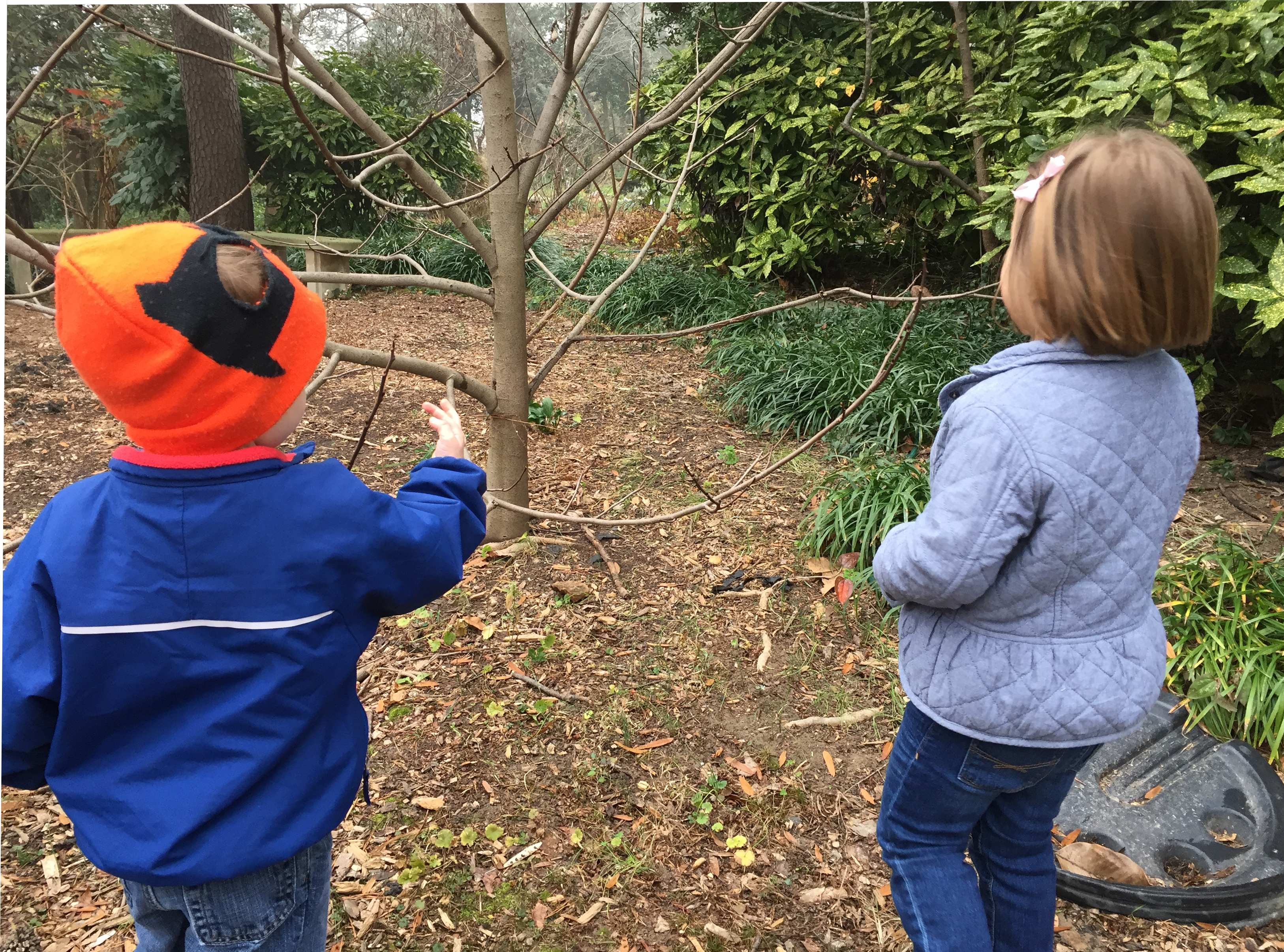A "Spring" in December
By Peggy Ashbrook
Posted on 2015-12-30

 The unusually warm December weather has brought out flowers in some of the plants that usually bloom in Spring in my area. Citizen scientists who participate in phrenology are documenting these observations. Phenology is an important subject to study, because it helps us understand the health of species and ecosystems.
The unusually warm December weather has brought out flowers in some of the plants that usually bloom in Spring in my area. Citizen scientists who participate in phrenology are documenting these observations. Phenology is an important subject to study, because it helps us understand the health of species and ecosystems.
Studying the timing of life cycle events in all living things, such as flower blooming or eggs hatching, is called phenology. The USA National Phenology Network describes it as “nature’s calendar—when cherry trees bloom, when a robin builds its nest and when leaves turn color in the fall.”
“Phenology is a key component of life on earth. Many birds time their nesting so that eggs hatch when insects are available to feed nestlings. In turn, insect emergence is often synchronized with leafing out in their host plants. For many people, allergy season starts when particular flowers bloom—earlier flowering means earlier allergies. Farmers and gardeners need to know when to plant to avoid frosts, and they need to know the schedule of plant and insect development to decide when to apply fertilizers and pesticides. Many interactions in nature depend on timing. In fact, phenology affects nearly all aspects of the environment, including the abundance, distribution, and diversity of organisms, ecosystem services, food webs, and the global cycles of water and carbon.”
Read about how children can participate and learn from phenology monitoring programs on the “Resources For K-4 Classroom Teachers” page from The USA National Phenology Network. It would be interesting for children to compare photographs of a particular tree or other plant from a particular day in previous years to the current year. My students have been observing a Paw Paw tree since October and I’ll save the photos for the 2’s and 3’s to look at next year.
Weather and environment experts, Nicholas Bond, Julia Kumari Drapkin, Richard Primack, and Noel Perry, talked with On Point‘s Tom Ashbrook (no relation that I know of) about the record high December 2015 temperatures.
The insects out in this warmer weather gave me subjects to photograph using a new 15x lens on my smart phone. I may use the lens to photograph objects children express interest in, but won’t let them handle it. I do let them use my digital camera because I learn what they are interested in as they document their observations.
- Who is eating this rose?
- A caterpillar on the underside!
- Details of a tiny insect (3mm) are revealed with a 15x lens/
I look forward to using the lens to photograph snowflakes!
Ideas and info from NSTA’s December K-12 journals
By Mary Bigelow
Posted on 2015-12-28
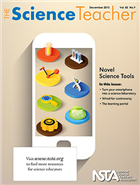 The Science Teacher: Novel Science Tools
The Science Teacher: Novel Science Tools
I once worked with a teacher who said that he would put off doing anything with technology until “things settled down.” I suspect he’s still waiting… The featured articles in this issue look at some current (as of now anyway) technologies that related to teaching and learning in science, such as mapping tools, digital probeware and sensors, and online simulations. The lessons show their connections to the NGSS.
- Wired for Controversy describes the materials and methodology used to explore ethics in autonomous systems through cyborg roaches and robotic insects. Sounds almost like science fiction!
- Turn Your Smartphone Into a Science Laboratory has several activities in which students collect and analyze data related to force and motion as al alternative to more expensive probes or monitors. We can use our phones in class!
- Where the Birds Live is another phone-enhanced activity in which students use real data and online maps to explore bird habitats, migration patterns, and biodiversity.
- Clearing the Air explores the greenhouse effect in the context of black-body radiation and Wien’s Law in a 5E lesson using online simulations.
- The Learning Portal describes a source of free classroom-tested web-based activities that use probes and models.
- Science 2.0: Did They Really Read It? Describes two online tools to assess student comprehension of reading and video resources. (See the authors’ related blog).
For more on the content that provides a context for these projects and strategies see the SciLinks websites for Acceleration, Birds, Biodiversity, Blackbody Radiation, Centripetal Force, Conduction Convection and Radiation, DNA Replication, Forces and Motion, Gravity, Greenhouse Effect, Max Planck, Migration of Birds.
Continue for Science Scope and Science and Children
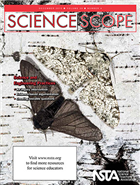 Science Scope: Science and Engineering Practices
Science Scope: Science and Engineering Practices
Assessing Science Practices: Moving Your Class Along a Continuum groups the eight science and engineering practices into three categories: investigating, sensemaking, and critiquing. The authors include an assessment tool and describe how it can be used during a lesson.
Other featured articles:
- Present, Critique, Reflect, and Refine is a four-step strategy to teach evidence-based argumentation.
- Authentic Science Investigation in the Classroom: Tools for Creating Original, Testable Questions and Graphical Hypotheses discusses the importance of asking questions and includes suggestions (such as flowcharts and inquiry boards) for helping student refine questions into testable ones.
- Argumentation and Explanation: Tools for Using Them Together While Keeping Them Separate includes graphic organizers and an example of an explanation template.
- The ICAN Intervention: Helping Science Learners Make Connections to Content During Inquiry has examples of “probes” that help students chart and reflect on their learning
- Everyday Engineering: Queuing Theory—Is My Line Always the Slowest? takes engineering concepts to the supermarket.
- Tried and True: Puff Mobile Derby Student Engineers demonstrate their learning by applying concepts from physics and engineering to the design of wind-powered vehicles.
For another engineering project, see Engineering Encounters: Creating a Prosthetic Hand from Science & Children.
For more on the content that provides a context for these projects and strategies see the SciLinks websites for Forces and Motion, Plant Growth, Plate Tectonics.
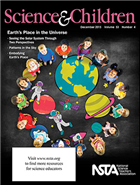 Science and Children: Earth’s Place in the Universe
Science and Children: Earth’s Place in the Universe
As always, the articles in this issue have ideas for classroom activities that align with the NGSS, along with photos of students, examples of their work, rubrics, and downloadable resources.
- Patterns in the Sky
has a 5E lesson for maximizing young students’ experiences before, during, and after a visit to a planetarium. - Seeing the Solar System Through Two Perspectives describes how a focus on learning progressions in modeling and observing patterns can help students develop their understanding of interactions between the Earth, sun, moon, and stars. (Part 2 will be published in a later issue).
- Embodying Earth’s Place in the Solar System shows how students can explore seasonal changes in how we see constellations.
- Fossil Explorers uses a 5E lesson to build on students’ curiosity about prehistoric life.
- Map That Find! has 5E lesson ideas for student archaeologists to apply their skills in observation, reasoning, hypothesis-testing, and mapping.
- Teaching Through Trade Books: Sunrise, Sunset, and Shadows has two activities with suggestions for related books in which K-2 students investigate what causes and affects shadows and 3-5 students examine the correlations between the amount of daylight and the seasons.
- The Early Years: The Earth-Sun System has ideas for younger learners as they investigate shadows.
- Formative Assessment Probes: Mountaintop Fossil: A Puzzling Phenomenon explores students’ knowledge of how fossils form and what we can learn from where they are found.
From the Science Teacher: Career of the Month: Earthquake Engineer
For more on the content that provides a context for these projects and strategies see the SciLinks websites for Archaeology, Constellations, Fossil Discoveries, Fossils, Fossil Record, Planets, Properties of Light, Seasons, Stars, Sun, Using Models in Earth Science.
 The Science Teacher: Novel Science Tools
The Science Teacher: Novel Science Tools
"Group" work in elementary science?
By Mary Bigelow
Posted on 2015-12-20
 I’m a first year teacher, teaching third grade. In my undergraduate work and student teaching, I worked with math and reading groups, but not much was mentioned about using small groups in science or social studies. I’m curious about how to go about setting up and managing group work in these subjects. —D., Washington
I’m a first year teacher, teaching third grade. In my undergraduate work and student teaching, I worked with math and reading groups, but not much was mentioned about using small groups in science or social studies. I’m curious about how to go about setting up and managing group work in these subjects. —D., Washington
In math and reading, you probably worked directly with small groups of students while the rest of the class did other activities. The small groups were structured based on student reading levels or achievements in math, and you tailored the instructional activities to meet the students’ needs.
In science and social studies, however, you’ll probably have the whole class working in groups on the same activity or rotating through a set of learning activities or stations. As the teacher, you will work with the groups as needed, but the groups will work without direct one-to-one supervision. This requires planning and organization, as well as instructions for the students on how to work safely and cooperatively.
If you do an online search for cooperative learning strategies for elementary students, you’ll find many different organizational strategies. But the literature is clear: assigning students to groups and giving them an activity is not necessarily the same as cooperative learning. It’s essential for each student to have a role in the group so they share the responsibility for learning. The roles may vary from one activity to another, but could include group leader, presenter, data recorder, measurer, equipment manager, liaison (to ask questions of the teacher or other teams), artist, online researcher, questioner, timekeeper, and notetaker.
Regardless of what roles you use, be sure that students understand their responsibilities.
These “job descriptions” could be in the form of checklists, a bulletin board display, index cards, or a page in the students’ science notebooks. The job descriptions could include mini-rubrics and conversation starters. I’ve seen teachers make “badges” for the students to wear to identify who is doing what job. Ask students to describe how they and their teammates did their jobs (this could be a exit activity). Rotate the roles so all students have a variety of experiences.
Most teachers would agree there is no “best” way to set up groups. Some teachers suggest grouping students by ability, as is often done in reading or math groups. I’m not sure how to determine science ability, especially at the third grade level, so I suspect teachers use factors such as reading or math grades, work habits, or behavior.
One option is to assign groups randomly. As the students work together, you can observe how different combinations of personalities work together: who are the leaders, the thinkers, and the creators; which students need closer supervision; which students clash; and which students struggle with the activities.
There are other student variables to consider. Depending on your observations, you may find single-gender groups provide more opportunities for equitable student participation (this was true for my seventh graders). If your class includes students with special needs, check with the special education teachers to determine their needs in terms of their individual education plans. If an activity requires a lot of reading, you may want to have a combination of reading abilities in each group.
To keep the groups focused and on-task, students should understand the expectations for the project or investigation, including any safety concerns. Monitor the groups as they work and provide feedback, listen to their discussions, and observe their interactions (this can be a formative assessment).
Some students may not have developed a high level of interpersonal skills. Start with brief and highly structured activities. Model what cooperative behavior “looks like,” and work with them on what types of language is appropriate in their groups.
Cooperative learning models also emphasize the importance individual accountability. You could have the group create some parts of a report together (perhaps in their notebooks, on chart paper, or on a online class page) and then have each student write or draw his or her own summary or conclusion. Some teachers hold each student be responsible for one part of a project, evaluating each component separately and then assigning a holistic evaluation for the entire project.
On a practical note, I found that having a color-coded box or tray for each group makes it easier to organize and count the materials and have everything is in place before going onto the next lesson.
There are times when cooperative learning is effective, times when large group instruction is appropriate, and times when you want students to work independently.
Don’t forget–teaching both science and social studies gives you an opportunity for some interesting interdisciplinary work!
 I’m a first year teacher, teaching third grade. In my undergraduate work and student teaching, I worked with math and reading groups, but not much was mentioned about using small groups in science or social studies. I’m curious about how to go about setting up and managing group work in these subjects. —D., Washington
I’m a first year teacher, teaching third grade. In my undergraduate work and student teaching, I worked with math and reading groups, but not much was mentioned about using small groups in science or social studies. I’m curious about how to go about setting up and managing group work in these subjects. —D., Washington
The Science of Art by guest blogger Carrie Heflin
By Peggy Ashbrook
Posted on 2015-12-19
Welcome to guest blogger Carrie Heflin! Carrie was a pre-k classroom educator at the Smithsonian Early Enrichment Center for four years. With everyday access to the museums on the National Mall, she developed her students’ understanding of art concepts. Her teaching put attention on the connections between artwork and science concepts. She is now the Professional Development Coordinator for the Smithsonian Early Enrichment Center and the Exhibit Coordinator for Wegmans Wonderplace at the National Museum of American History.
As early childhood educators, we are all familiar with the questions that weigh on parents’ and caregivers’ minds: How does my child’s development stack up to that of her or his peers? What should I be doing at home to help my child learn more, faster? What kind of school is best for my child?
Educators and school administrators constantly make difficult decisions regarding the quality and content of the educational experience they are able to provide for their students. We are aware that young children need sensory experiences and multiple exposures to materials to ensure that they are properly able to learn new skills and remember information. Adding more Arts-based programming into the curriculum is a logical way to accomplish these goals because art comes naturally in many forms such as painting, sculpture, literature, theater and music.
These media can engage various senses and reinforce ideas both through their more passive interactions, such as watching a play or looking at a painting, and through hands-on creation. However, the Arts are often under-utilized in school settings because proper training on their cross-curricular use is not made available to educators and funding for such trainings and programs is lacking. Many people also consider the Arts to be an intimidating field. They understandably feel ill equipped to teach using subject matters with which they are not familiar. There are some simple tips one can follow to start thinking about and using the Arts more in the classroom- regardless of subject matter or grade level.
 First, start looking for connections. Time and again we are asked to weed out any subject whose contribution toward success cannot be weighed and measured in neat letters and numbers and to cast it aside. However, as any early childhood educator can tell you without hesitation, one area of learning and development cannot be separated from another. You cannot ask whether music is more important than math because music is math. Each note represents a fraction of a measure. Each bar is the sum of its notes. Science cannot be separated from art. Every building or monument on this planet is equal parts a testament to its architect’s engineering skills and her or his creativity. Literature cannot be separated from its dramatic representation in the theater because words are meaningless unless there are people sharing them with each other.
First, start looking for connections. Time and again we are asked to weed out any subject whose contribution toward success cannot be weighed and measured in neat letters and numbers and to cast it aside. However, as any early childhood educator can tell you without hesitation, one area of learning and development cannot be separated from another. You cannot ask whether music is more important than math because music is math. Each note represents a fraction of a measure. Each bar is the sum of its notes. Science cannot be separated from art. Every building or monument on this planet is equal parts a testament to its architect’s engineering skills and her or his creativity. Literature cannot be separated from its dramatic representation in the theater because words are meaningless unless there are people sharing them with each other.

Ernesto Neto, “The Dangerous Logic of Wooing,” 2002. Installation view of “At the Hub of Things: New Views of the Collection” at the Hirshhorn Museum and Sculpture Garden, Smithsonian Institution, Washington DC, 2014. Photo: Cathy Carver
Second, apply the connections between broader subject matters to specific pieces of works of art. With very little prompting, even a young child can look at a work of contemporary art like Ernesto Neto’s The Dangerous Logic of Wooing and make the connection between a massive sculptural installation and the principles of physics. I have seen it happen through my work as an educator at the Smithsonian Early Enrichment Center (SEEC). My pre-k class went to see this piece by Neto and talked about how the way the sculpture is suspended from the ceiling is a good visual representation of the pull of gravity. I showed my class images of astronauts in space who are floating around and talked about how gravity is the force that keeps us from floating around here on earth. We don’t usually notice it, but it can be seen in the way big objects, like this sculpture, hang down when they are suspended. The curator of this museum exhibition and the artist who created the piece had to work together to develop a system for hanging it that would be strong enough to hold up the massive artwork against the force of gravity that is pulling on it.
 Then we thought about how the force of gravity affects the way our own bodies move around. We performed the basic motions of raising our arms and lifting our feet and talked about how our muscles and bones have to work against gravity just to allow us to move around. In a later lesson about muscles, we applied our experience of the force of gravity to talk about why we have to exercise and strengthen our muscles in order to perform harder tasks such as running fast or lifting heavy objects. Months later, I heard pieces of my lessons being incorporated into play scenarios where my students were talking about making their leg muscles stronger by doing a lot of running.
Then we thought about how the force of gravity affects the way our own bodies move around. We performed the basic motions of raising our arms and lifting our feet and talked about how our muscles and bones have to work against gravity just to allow us to move around. In a later lesson about muscles, we applied our experience of the force of gravity to talk about why we have to exercise and strengthen our muscles in order to perform harder tasks such as running fast or lifting heavy objects. Months later, I heard pieces of my lessons being incorporated into play scenarios where my students were talking about making their leg muscles stronger by doing a lot of running.
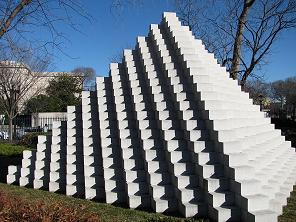
Sol LeWitt “Four-Sided Pyramid”, 1999, first installation 1997 National Gallery of Art, Washington Gift of the Donald Fisher Family. Photograph of artwork taken by Slowking4.
Creating art is also an excellent way to introduce concepts of physics and engineering. When my class was learning about ancient Egypt, we went to see Sol Lewitt’s Four-Sided Pyramid at the National Gallery of Art Sculpture Garden to encourage thinking about how the various pyramids of ancient Egypt were built. We brought plastic Lego blocks along to demonstrate some possible shapes that wouldn’t work with the building materials on hand. For instance, the children figured out very quickly that the base of the structure needed to be larger than, or at least equal to, the size of the top or it would tip over. Then we tried to create a pyramid model, working from the design of the sculpture and images of the Great Pyramids. Individual children were able to use the Lego blocks to create an object that closely resembled the sculpture, but we were unable to make a smooth-sided pyramid. The class concluded that we either, didn’t have enough blocks, or didn’t have the right kind of blocks. This kind of hands-on problem solving, inspired by a sculpture, created a lasting impression on my class. It has been over two years since our first lesson and one student still regularly teaches lessons on Egypt to his family when they come to the museums.
This is just a small example of what the Arts can add to a classroom experience. If you don’t have access to a museum or gallery on a regular basis, use technology. Th
ere are countless images available online that can help bring art to you and your students. Be creative, look for connections between art and science concepts, and remember: Art, in all its many forms, is the human representation of knowledge that gives it meaning. When we take away that meaning, we aren’t setting our children up for success. We are setting them adrift in a sea of numbers and letters without context or purpose.
Welcome to guest blogger Carrie Heflin! Carrie was a pre-k classroom educator at the Smithsonian Early Enrichment Center for four years. With everyday access to the museums on the National Mall, she developed her students’ understanding of art concepts. Her teaching put attention on the connections between artwork and science concepts.




